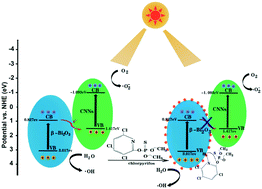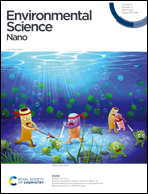A highly efficient photoelectrochemical sensor for detection of chlorpyrifos based on 2D/2D β-Bi2O3/g-C3N4 heterojunctions†
Abstract
The development of an effective and stable photochemical sensor is urgently needed to solve the growing environmental pollution problem caused by immoderate usage of the organic phosphorus pesticide, chlorpyrifos. Under the circumstances, 2D/2D Z-scheme β-Bi2O3/g-C3N4 heterojunctions have been attempted to fabricate a photoelectrochemical sensor, which can detect chlorpyrifos selectively and sensitively. The 2D/2D intimate contact interfaces could facilitate the separation and migration of electron–hole pairs. Consequently, β-Bi2O3/g-C3N4 composites possess higher photocurrent response than single β-Bi2O3 and g-C3N4. After incubation with chlorpyrifos, in situ formed Bi–chlorpyrifos complex blocks the transformation of photogenerated charges, and thus contributes to a dramatic decline in photocurrent signal intensity and selective determination of chlorpyrifos. The novel photoelectrochemical sensor with strong stability presents a perfect linear relationship between photocurrent intensity and logarithm of chlorpyrifos concentration ranging from 0.01 to 80 ng mL−1, and displays excellent properties over a wide linear range with an ideal detection limit of 0.03 ng mL−1 (S/N = 3). To some extent, the Z-scheme β-Bi2O3/g-C3N4 sensor is promising for the detection of chlorpyrifos pesticides in practical environmental pollution treatment applications.



 Please wait while we load your content...
Please wait while we load your content...